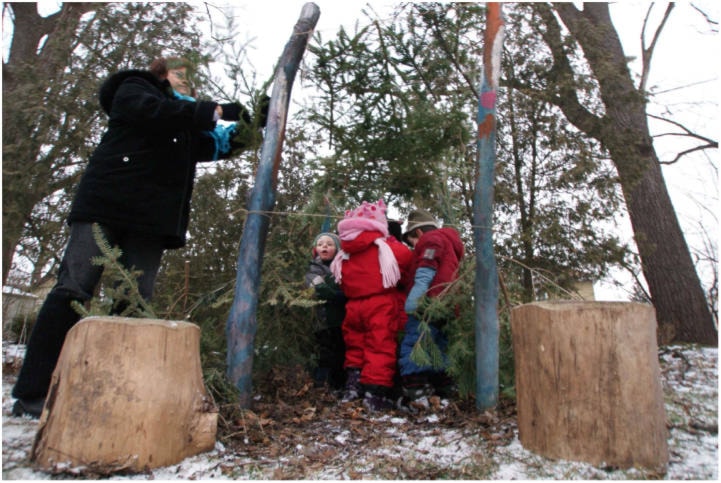HAMILTON, Ont. – For children, Christmas trees can still provide wonder and magic long after the holidays are over, says Jill Bienenstock, RECE and Education Director, Bienenstock Natural Playgrounds.
The early childhood educator, who specializes in nature play, is encouraging teachers, parents, and caregivers to repurpose the season’s influx of discarded Christmas trees to provide learning and developmental opportunities for youth.
“In broad terms, nature play involves interacting with natural landscape features, landforms, natural materials, and plants – so why not put Christmas trees on double duty?” says Bienenstock, who spearheads innovative training workshops geared toward connecting children to nature.
“The best part about reusing Christmas trees for outdoor education is that the learning materials are free and ready for the picking in January.”
Bienenstock says having children manipulate discarded Christmas trees through a number of activities, including those outlined below, can provide them with:
• Hands-on, outdoor learning about habitats and structures
• Key learning concepts related to math and science
• Opportunities to problem-solve, collaborate, and exercise language and motor skills
“More time in nature-rich environments encourages resilience, emotional and physical health, and creative thinking in children,” Bienenstock says. “Statistics and academic research also show a link to lower incidents of vandalism and bullying, higher test scores, greater attention spans, and increased balance and agility.”
For these reasons, Bienenstock says natural playgrounds, playscapes, nature play areas, and outdoor learning environments are on the rise.
“Designed to put kids in direct contact with nature with a focus on the value of play, these spaces are gaining popularity among municipalities, school districts, and childcare centres across Canada, and beyond,” Bienenstock adds.
Below is a list of activities children can participate in using discarded Christmas trees:
Fort making: Whole trees, their sticks and cut branches make for awesome tree fort building.
Giant bird feeders: Hanging pine cone seed feeders, popcorn and cranberry strands on replanted Christmas trees allows children to revisit the holidays as they decorate for feathered friends. The activity also lets kids observe which birds, and other animals, stay home for the winter rather than migrate.
Bird shelters: Fastening Christmas trees along a fence can act as shelter from the wind and cold for many birds that do not migrate in winter.
A giant, child-sized nest: Cut branches make for an impressive nest in which children can play.
A magical forest: Replanting small groupings of Christmas trees can create a magical forest to explore. Teachers, parents, caregivers, and children can trim the bottom branches for better supervision.
Snow creatures: Cut branches and needles can make for chilling snow creatures.
Heavy-work opportunities: Lugging Christmas trees around a play space provides heavy-work opportunities for kids, which supports the development of core strength, co-ordination, balance, as well as body awareness and self-regulation.
Sensory-rich experiences: By moving a tree around, children take in its refreshing aroma. By jumping and rolling on the trees, they experience the touch and feel of branches and needles.
Please note: For activities that call for cutting branches, teachers, parents, caregivers, and children are advised to use handsaws that have a “D handle,” so that both hands can fit inside. These handsaws have small teeth to eliminate the saw from jumping around while being used.
About Jill Bienenstock
Jill Bienenstock is an early childhood educator with more than 20 years experience in various educational settings. Currently, Bienenstock is the Director of Education at Bienenstock Natural Playgrounds, an award-winning design and build firm that creates natural playgrounds using locally sourced, and handcrafted materials. Bienenstock specializes in finding creative ways to extend educational curriculum outdoors, making it simple and fun for both students and educators. She finds inspiration in the children she works with, and in transforming outdoor obstacles into learning opportunities for all. Bienenstock and her team are available for training and workshops, keynotes, panel discussions, guest lectures, writing projects, and editorial interviews.
